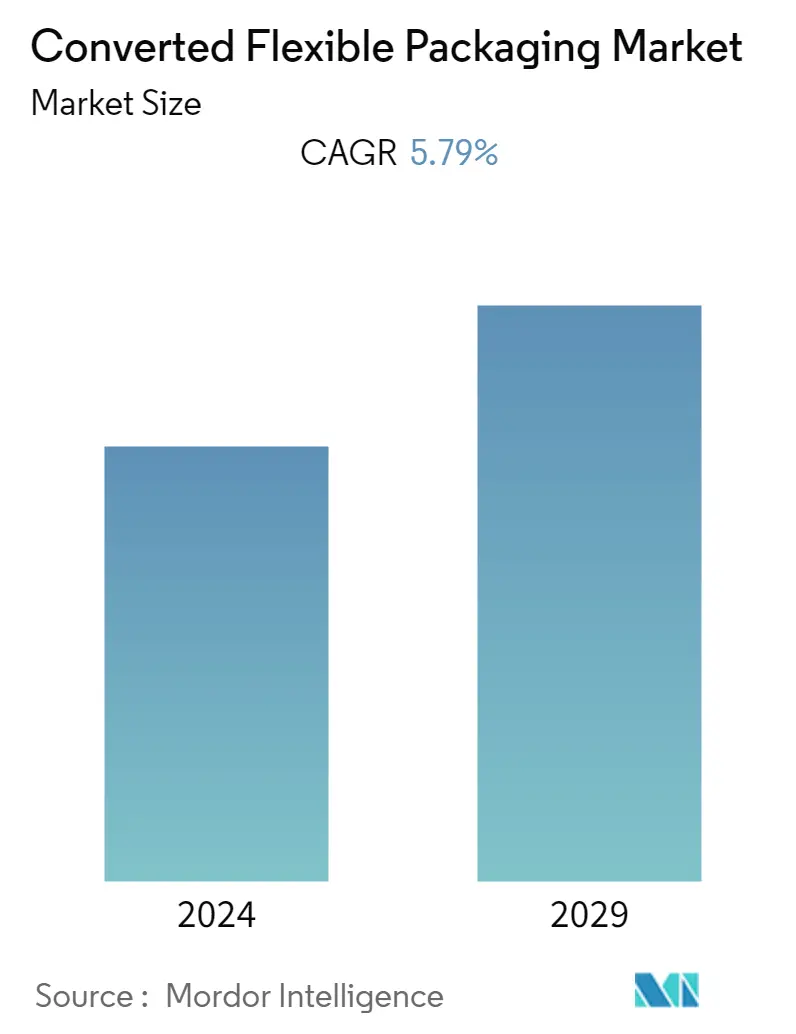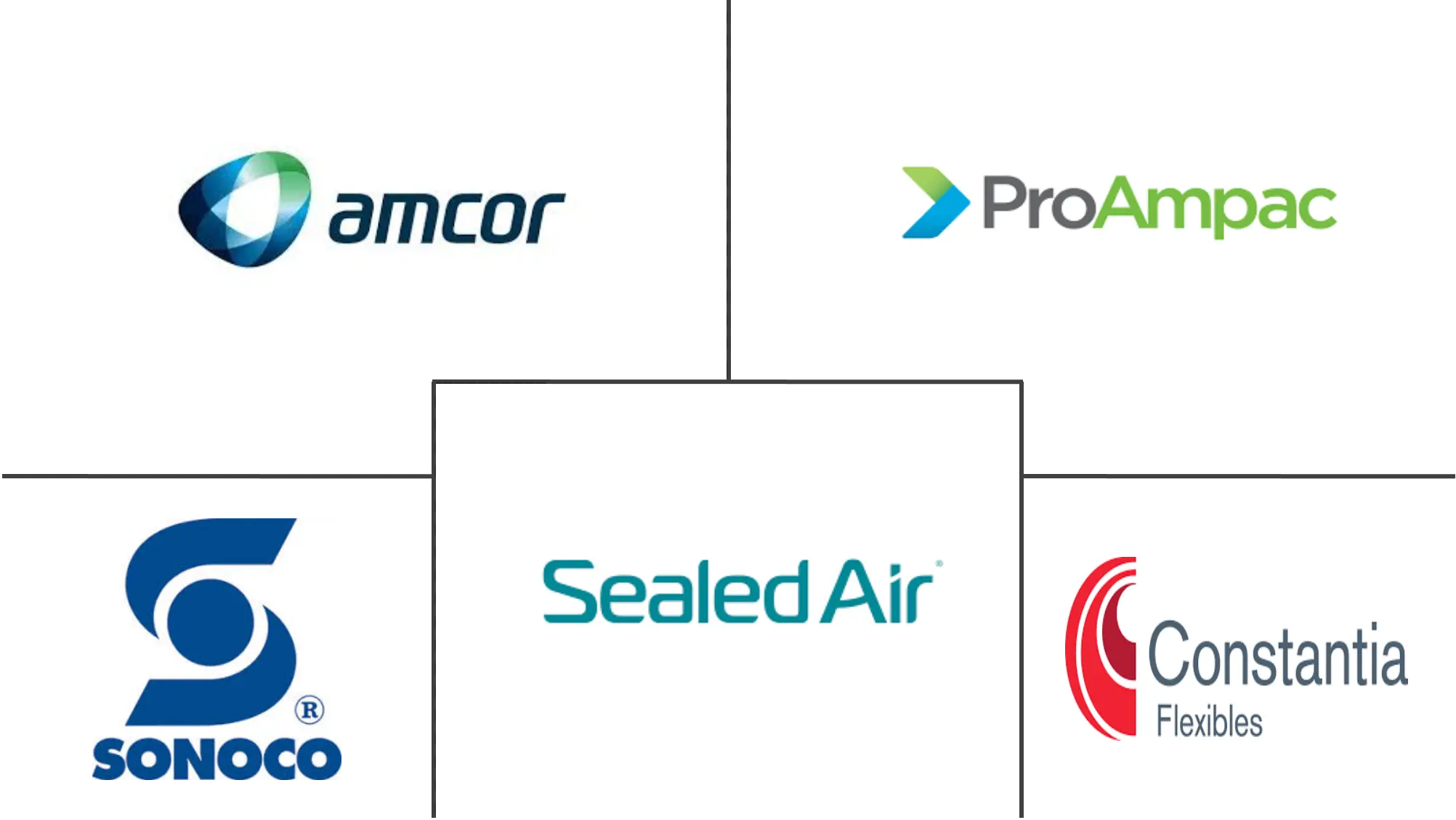Market Size of Converted Flexible Packaging Industry

| Study Period | 2019 - 2029 |
| Base Year For Estimation | 2023 |
| CAGR | 5.79 % |
| Fastest Growing Market | Asia Pacific |
| Largest Market | North America |
| Market Concentration | Medium |
Major Players
*Disclaimer: Major Players sorted in no particular order |
Converted Flexible Packaging Market Analysis
The Converted Flexible Packaging Market is expected to reach a CAGR of 5.79% during the forecast period (2022 - 2027). Innovative packaging and growing utilization in end-user industries such as food & beverage, pharmaceuticals, and health & beauty are expected to promote market forecasts. The ongoing conversion from rigid to flexible formats and consumer interest in single-use packaging will continue to drive the market.
- The increasing demand for convenience-oriented processed products such as food is driving the need to transform flexible packaging, as they typically use high-barrier, high-grade packaging materials for longer shelf life. The industry is also noticing an increasing trend towards environmentally friendly formats. Innovative products such as auto-venting films that allow frozen and other foods to be steamed inside the package could represent a breakthrough in technology improvement and development.
- The growing e-commerce market in various countries creates special demand for cardboard and corrugated products, especially from transportation and logistics companies. In addition, the environmental friendliness of packaging materials has made them more popular and is driving the market.
- Further, aluminum foil is one of the popular packaging materials for converted flexible packaging. Many products, from food and beverages to cosmetics, are packaged in aluminum to maintain product integrity throughout their shelf life. According to European Aluminum Foil Association, the first three months of 2021 saw deliveries from European foil rollers reach 245,000 tonnes, up by 2.3% compared to 2020 (239,500 tonnes), led by striving performance in overseas markets, where the growth of over 10% was achieved.
- The transformed flexible packaging industry is being challenged by rising material costs and increased demand for products such as low-fat snack foods. These products require innovative technology and material combinations to meet packers' freshness needs. Technological advances include controlled and modified atmosphere (CAP/MAP) packages, resulting in much longer shelf life for produce, meat, and other products.
- The recent outbreak of COVID-19 has left converted flexible packaging manufacturers in a deluge of concerns expected to be short-lived. The pandemic lockdown impacts include supply chain disruptions, unavailability of raw materials used in manufacturing, labor shortages, price volatility that can bloat end product production and exceed budgets, and shipping issues. etc. is included.
Converted Flexible Packaging Industry Segmentation
Converted flexible is a packaging type that combines raw materials such as adhesives, plastics, polyesters, paper & paperboard to create new packaging results, such as bags and pouches. It is broadly utilized by end-users such as food & beverages, consumer goods, pharmaceuticals, and personal care. The studied market briefs about the COVID-19 impact on the market and key trends adopted by major global players.
The Converted Flexible Packaging Market is segmented by Material (Plastic Film, Paper, Aluminum Foil), by Application (Retail, Food & Beverage, Pharmaceutical, Non-Food), and Geography.
| By Material | |
| Plastic Film | |
| Paper | |
| Aluminum Foil | |
| Other Materials |
| By Application | |
| Retail | |
| Food & Beverage | |
| Pharmaceutical | |
| Non-Food | |
| Other Applications |
| Geography | |
| North America | |
| Europe | |
| Asia Pacific | |
| Rest of the World |
Converted Flexible Packaging Market Size Summary
The Converted Flexible Packaging Market is poised for significant growth, driven by the increasing demand for innovative and convenient packaging solutions across various industries, including food and beverage, pharmaceuticals, and health and beauty. The shift from rigid to flexible packaging formats, coupled with consumer preferences for single-use and environmentally friendly options, is expected to bolster market expansion. The rise of e-commerce further fuels the demand for flexible packaging, particularly in transportation and logistics sectors. Technological advancements, such as auto-venting films and controlled atmosphere packaging, are enhancing the functionality and shelf life of packaged products, addressing the growing need for convenience-oriented processed goods.
The market is characterized by a moderate level of competition, with key players like ProAmpac, Amcor Plc, and Sonoco Products Company leading the charge through strategic acquisitions and expansions. The Asia Pacific region, with its burgeoning markets in China and India, presents substantial growth opportunities, supported by increasing consumption of packaged foods and seafood. Innovations in sustainable packaging solutions, such as Graphic Packaging International's EnviroClip and Amazon's recycled paper packaging, are driving the market forward. Despite challenges like rising material costs and supply chain disruptions, the market is expected to continue its upward trajectory, supported by the ongoing demand for flexible packaging solutions that meet the evolving needs of consumers and industries alike.
Converted Flexible Packaging Market Size - Table of Contents
-
1. MARKET DYNAMICS
-
1.1 Market Overview
-
1.2 Introduction to Market Drivers and Restraints
-
1.3 Market Drivers
-
1.3.1 Augmented Demand for Convenient Packaging
-
1.3.2 Need for Longer Shelf Life and Changing Lifestyles
-
-
1.4 Market Restraints
-
1.4.1 Concerns about the Environment and Recycling
-
-
1.5 Value Chain / Supply Chain Analysis
-
1.6 Industry Attractiveness - Porter's Five Force Analysis
-
1.6.1 Threat of New Entrants
-
1.6.2 Bargaining Power of Buyers/Consumers
-
1.6.3 Bargaining Power of Suppliers
-
1.6.4 Threat of Substitute Products
-
1.6.5 Intensity of Competitive Rivalry
-
-
1.7 Impact of Covid-19 on the market
-
-
2. MARKET SEGMENTATION
-
2.1 By Material
-
2.1.1 Plastic Film
-
2.1.2 Paper
-
2.1.3 Aluminum Foil
-
2.1.4 Other Materials
-
-
2.2 By Application
-
2.2.1 Retail
-
2.2.2 Food & Beverage
-
2.2.3 Pharmaceutical
-
2.2.4 Non-Food
-
2.2.5 Other Applications
-
-
2.3 Geography
-
2.3.1 North America
-
2.3.2 Europe
-
2.3.3 Asia Pacific
-
2.3.4 Rest of the World
-
-
Converted Flexible Packaging Market Size FAQs
What is the current Converted Flexible Packaging Market size?
The Converted Flexible Packaging Market is projected to register a CAGR of 5.79% during the forecast period (2024-2029)
Who are the key players in Converted Flexible Packaging Market?
ProAmpac, Amcor Plc, Sealed Air Corporation , Sonoco Products Company and Constantia Flexibles Group GmbH are the major companies operating in the Converted Flexible Packaging Market.

